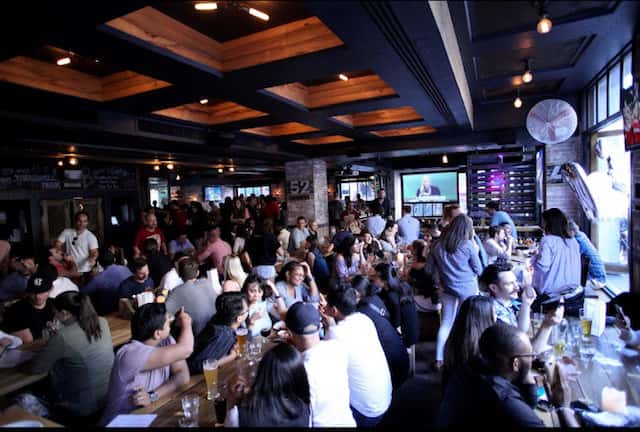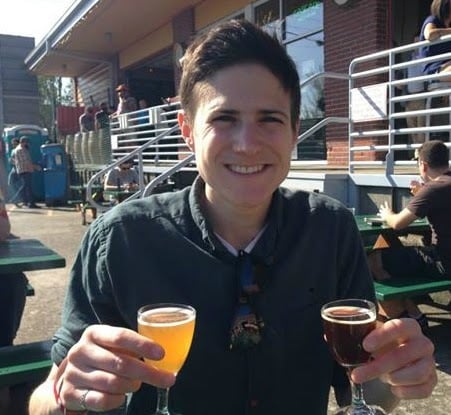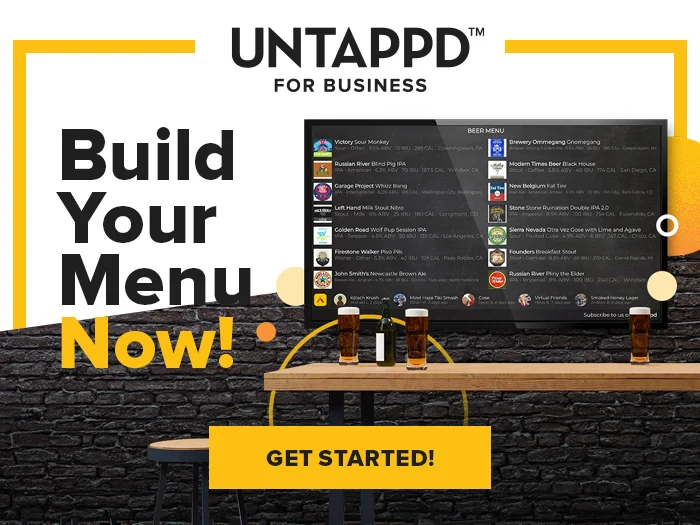
UPDATED: 1/19/23
Two words: Increased revenue. That will continue to be the name of the game in 2023 as breweries, taprooms, bars, and restaurants have all returned to a “new normal” style of business and continue to deal with supply chain and economic challenges.
In the past, we’ve written about several strategies to help hospitality establishments generate increased revenue, including starting a mug club, the best bars games to attract patrons to your brewery, and the best ways to display QR codes. But another top tactic is to establish a happy hour, or to find more creative happy hour ideas.
Happy hours can be a simple strategy to attract new consumers, create loyal fans, and bring in more revenue during non-peak business times. They’re a win-win-win.
With that in mind, we put together a list of some of the top happy hour ideas to generate increased revenue, whether you’re considering the idea for the first time or you’re looking to bring some fresh post-COVID perspective to a tried and true tactic.
What We’ll Cover in This Piece:
What Is the Point of a Happy Hour?
Generally, happy hours provide discounted drinks and/or food options to patrons within a specified time of the day. Attracting colleagues grabbing a drink after work, friends looking to meet up, or even couples out for a date, happy hours are great ways to bring in customers to your bar or restaurant during early or off-hours. Happy hours can also create brand loyalty, increase sales, and even bring new people into your establishment.
According to data from integrated-point-of-sale provider Cake of over 400 bars, those with happy hours have thirty-three percent higher transactions than those without. During happy hour times, they also see an average increase in revenue of twenty-six percent and transactions increase by twenty-four percent.
Bottom line: Happy hours can generate more revenue for your bar.
What Are the Best Ways to Run a Happy Hour?

Photo hq_chicago via Instagram
When thinking about implementing a happy hour, a business needs to make three decisions.
First, you need to decide the day or days your happy hours will take place. Businesses also need to decide the times to run happy hours on those days, as well as the discounts to offer.
Typically, happy hours happen during the work week, Monday through Friday, and somewhere between the hours of 4:00 PM and 7:00 PM. Essentially, at off-times when your establishment would otherwise be slow. According to a Newsweek study, twenty-three precent of works identified 4:00 PM to 5:00 PM on a weekday as the best time for a happy hour.
In particular, Newsweek reported that eighteen percent of Americans enjoy a happy hour on Tuesday while seventeen percent prefer Friday.
In contrast, a 2018 Nielsen survey reported that most Americans enjoy happy hours on Wednesdays, generating 23.9% more sales than other weekdays.
“Happy hours are a great tool to encourage guests to come during the slower hours or times when it’s not so busy,” says Anne Becerra, the Cicerone and Beer Director at Treadwell Park, a craft beer bar with three locations throughout Manhattan, NY. “For most bars, especially in New York, the real estate and labor cost are often more of an investment than the product itself. If [a bar] wants to continue to operate, happy hours offer a little more flexibility. You generally don’t need as much staff during those times and there’s not as much turnover or competition for seating at those times.”
But it’s worth considering experimenting with these times. How about a happy hour at lunch? What about one late at night?
At Tiger’s Taproom, a neighborhood bar in Oakland, CA, owner Brian Chan says he started running a happy hour during the pandemic at peak times on Friday nights to help drive his draft sales. Chan offered folks $1 or $2 off 32oz growler fills.
“That drove my Friday, because that was our huge day,” says Chan. “We would have a line down the block of people trying to get cans and draft, so I thought I might as well take advantage of that super busy day and offer incentive to make it even busier.”
Beyond the timing, happy hours should provide an incentive for patrons, usually in the form of discounted drinks or food.
According to Statista, forty-six percent of happy hour goers are looking for well-priced drinks, but right behind them forty-one percent of consumers reported a desire for discounts on food as well. Building your happy hour around both discounts on drinks and food will increase your chances of attracting guests. And, keep in mind that the typical happy hour consumer often visits a bar or restaurant in a group, meaning shareable dishes or pitchers are a great option.
Lastly–and this is really the pivotal point of a happy hour–give your discounted offers a time limit. Normally, somewhere between two to three hours is standard. By providing parameters, your happy hour guests will feel an urgency to purchase fare to take advantage of the deals. And psychologically, there’s an element of exclusivity to taking part in a special hour or two of deals.
Check the Local Legalities Around a Happy Hour
A quick note — we’re not lawyers and can’t give legal advice. So implement these ideas at your own risk!
If you’re starting a happy hour program for the first time, make sure to check your local laws. Many states restrict–or even ban–happy hour promotions. Currently, the following eight states have outright bans on happy hours: Alaska, Indiana, Massachusetts, North Carolina, Oklahoma, Rhode Island, Utah, and Vermont.
Even in the states that do allow happy hours, the restrictions can sometimes be confusing. For example, while Virginia does allow happy hour drink specials, it’s illegal to mention these promotions in any type of advertising outside the bar. And in Oregon, while drink deals during happy hour and advertising are allowed, adding the prices in your advertisement is not. Other states won’t let bars offer drinks deals late at night.
This means that before you implement any of the following ideas, you need to check your local Alcoholic Beverage Control office or respective commission. You can find a list of each state’s representative authority here.
What Are the Top Happy Hour Ideas Right Now?
From themed nights to unique events, the creativity associated with your happy hours can be limitless. All told the average American spends about $68.99 during a happy hour (Simple Texting). With the potential to increase sales, build more brand loyalty, and attract new customers, developing a happy hour program should be in every business owner’s back pocket.

Photography courtesy of Treadwell Park
#1: Unique Flight Options
Give a discount on a tasting flight. This can include a variety of options from beer pours to wine or even spirits. Create small portions of four to five drinks and let people wet their whistle by choosing from one of your hand-picked selections.
#2: Pint + Plate Pairings

Photography courtesy of Treadwell Park
What’s better than one discounted drink or one discounted menu item? According to Statista, the top reasons for U.S. consumers to attend a happy hour is more reasonably priced food. In fact, sixty-three percent of those surveyed stated cheaper food as their reason for going to a happy hour.
Why don’t you try pairing a few pints and bites together for one overall special? While Treadwell Park offers the standard discounted draught beer, wine by the glass, and few select food items, Becerra says that their most popular happy hour special is the Berger & Burger combo. The bar offers a 16oz Radeberger pilsner alongside a junior burger for only $10. Take a look at your menu and highlight one item and pair it with a select draft for a double whammy that will be hard for patrons to resist.
#3: Target a Theme
Give people an engaging reason to come to your bar, taproom, or restaurant. Develop certain theme nights. For example, Tropical Tuesdays, where anyone that comes in wearing a Hawaiian shirt gets a discount on a rum-based cocktail. Or a Star Wars night, where anyone that shows up with a lightsaber gets a $4 pint. We’re getting super creative here, but the sky’s the limit. Just remember that understanding your core consumer is critical. We’ve stressed this before as a best practice when creating a craft beer logo or label: Understanding who you are as a brand and who your typical customers are will be crucial to every business decision you make, including building out a happy hour program. If you’re mainly a sports bar it might not make sense to create a night centered around, say, Shakespearean plays.
#4: Flip a Coin or Spin a Wheel
The idea here is simple, though definitely check your state laws here to see if it’s legal! With this concept, you give your guests the opportunity to win a discount. Because people can’t resist a low-stakes gamble! Set a list of eligible items such as domestic drafts, house wine, or well drinks. Anyone that plays the game has an opportunity to win something like half off that particular drink simply by flipping a coin or spinning a wheel. This tactic requires little to no cost up front and is a fun way to engage your patrons.

Photography courtesy of Tiger’s Taproom
#5: (Un)Happy Hour
Normally, happy hours involve discounts on basic items like well drinks, house wine, or draft beer. Take it up a notch and offer a deal on just one exclusive beverage. Make a batch of a high-quality cocktail, something that works well in large amounts like a sangria or punch. Rotate the flavors of this seasonally and then, during happy hour, offer it at half price. Chances are, your guests will still grab a draft beer or food on the side, so this could be a really smart play. Plus, if you have any leftover liquor that isn’t selling well and you’re looking to use it up, this could be the perfect opportunity.
#6: Elevate your Events
Give people a whimsical and quirky reason to visit your bar or taproom on an off-night of the week. Sure, we’re all down for Trivia Tuesdays, but again this is where your creativity can shine.
“Everyone in my neighborhood does trivia. I don’t want to do that,” says Chan. “I have to come up with other ways and events to bring more people in.”
For example, Chan recently hosted a tap takeover with the well-known Iowa-based brewery Toppling Goliath to celebrate their first time distributing in the Bay Area. He’s also hosting a similar event with Liquid Gravity Brewing Co.
“I’m getting super exclusive taproom-only beers,” says Chan.
And in addition to beer-focused events, Chan plans to bring back live music. He’s also toying with organizing other successful events he ran before the pandemic such as chili cookoffs, neighborhood potlucks, and Friendgivings.
“I’m just trying to think of other unique things to do,” says Chan.
Decide what event might be a good fit for your business. Can you invite a local artist to host a pop-up or sip-and-sketch night on a Monday? Create a Skee-Ball or darts league on a Tuesday? Play ‘80s movies on the big screen on Wednesdays? Or offer local rec sports teams a special happy hour on Thursdays?
Let your imagination run wild.
Other Content You May Enjoy
To succeed and grow your restaurant, bar, or brewery you need to stand out in local search results. Whether someone is searching for the “best craft beer near me” or “top-rated seafood restaurant in [your city],” Local SEO (Search Engine Optimization) helps your business appear at the top of those search results.
With 81% of consumers using Google Search and Maps to find local businesses, and nearly 90% of customers choosing a business on the first page of search results, optimizing your online presence is essential.
This guide will walk you through Local SEO strategies tailored for restaurants, bars, and breweries, covering Google My Business, website optimization, online reviews, local backlinks, and more.
By the end of this guide, you’ll have a step-by-step action plan to increase your search rankings, attract more local customers, and grow your business.
In today’s digital world, having a well-designed, functional website is essential for restaurants, bars, and breweries. It goes beyond having social media. A great website can help attract new customers, showcase menus, accept reservations, and even drive online sales. But one of the most common questions business owners ask is: How much should a website cost in 2025?
The answer depends on several factors, including the type of website, features, complexity, and whether you choose a DIY solution or hire a professional web developer. Costs can range from a few hundred dollars for a basic website to tens of thousands for a fully customized, feature-rich platform.
This guide will break down website costs for restaurants, bars, and breweries, helping you understand the pricing landscape and choose the best solution for your business
Trivia nights have become an incredible marketing strategy for bars, restaurants, and breweries to draw in crowds and engage with new customers. With the recent collaboration between Geeks Who Drink, Timeplay, and the iconic television show Jeopardy!, businesses now have an exciting opportunity to host the Jeopardy! Bar League. This partnership combines the global brand recognition of Jeopardy! with Timeplay’s cutting-edge technology and the fun of live trivia from the experts at Geeks Who Drink.
In this piece we’ll cover what this new collaboration between these two trivia powerhouses is and how you can bring this unique experience to your venue.
In today’s world, both websites and social media platforms are crucial for a brewery, bar, or restaurant’s online presence. However, consumer habits show distinct preferences for each, depending on the context of their search or interaction.
In this guide, we’ll go over the basics, walk you through how to leverage these tools effectively, and show you how understanding these trends can help your venue better meet your customers’ expectations.
As a restaurant, bar, brewery, or any venue with a food and beverage program, having a modern, functional, and aesthetically pleasing website isn’t just a luxury—it’s a necessity.
No matter the size of your business, your new potential customers often interact with your website first—and first impressions matter.
In this piece, we’ll explore the top website trends shaping the online presence of hospitality businesses in 2025. These trends will help your venue stand out and attract more customers while creating a unique and modern experience to establish the perfect guest experience from start to finish.
For bar owners, hospitality managers, and small business owners, selecting the right gin brands is more than just filling the shelves—it’s about curating a distinctive customer experience. Gin has soared in popularity, becoming a staple of modern cocktail culture. With its complex botanical infusions, gin offers versatile, memorable flavors that can attract a wide range of customers. But with so many choices available, which brands should you prioritize to bring out the best in your gin menu?
This guide explores the seven best gin brands that have proven themselves through quality, craftsmanship, and unique flavor profiles. By understanding what makes each brand special, you and your staff will be better equipped to create a standout gin selection that delights your patrons, reinforces your brand’s reputation with a robust gin drinks menu, and helps you continue crafting classic and innovative gin cocktails.

